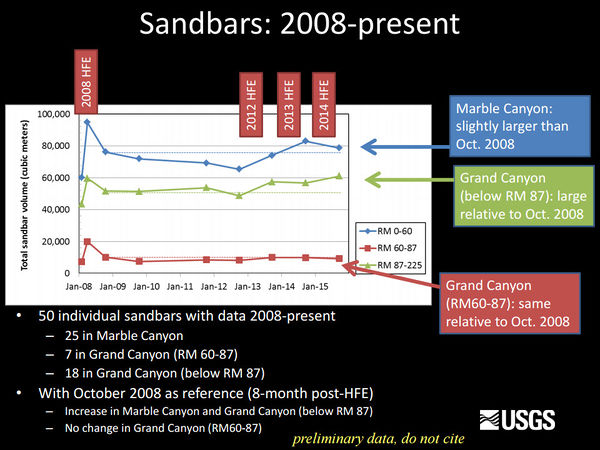|
|
Links and Information
|
|
|
Sediment Gages
|
|
|
Sand Mass Balance Reaches in Grand Canyon
|
|
|
Presentations and Papers
|
|
2016
- Voichick, N., Kennedy, T.A., Topping, D.J., Griffiths, R.E., and Fry, K.L., 2016, Water clarity of the Colorado River—Implications for food webs and fish communities: U.S. Geological Survey Fact Sheet 2016–3053, 4 p.
- Sandbar Modeling Project Update
- Status of Sediment Resources – August 2016
- Grand Canyon Monitoring and Research Center Science Updates and PPT (BO Compliance, Trout Updates, Green Sunfish, Fisheries PEP, Partners in Science)
- East, A.E., Collins, B.D., Sankey, J.B., Corbett, S.C., Fairley, H.C., and Caster, J., 2016, Conditions and processes affecting sand resources at archeological sites in the Colorado River corridor below Glen Canyon Dam, Arizona: U.S. Geological Survey Professional Paper 1825, 104 p., http://dx.doi.org/10.3133/pp1825.
- Topping, D.J., and Wright, S.A., 2016, Long-term continuous acoustical suspended-sediment measurements in rivers—Theory, application, bias, and error: U.S. Geological Survey Professional Paper 1823, 98 p., http://dx.doi.org/10.3133/pp1823.
- Brian D. Collins, David R. Bedford, Skye C. Corbett, Collin Cronkite-Ratcliff and Helen C. Fairley, 2016, Relations between rainfall–runoff-induced erosion and aeolian deposition at archaeological sites in a semi-arid dam-controlled river corridor, 19 p., Earth Surf. Process. Landforms
- Project 2: Streamflow, Water Quality, Sediment Transport, and Sand Budgets in the Colorado River Ecosystem
- Sandbars and Sediment Storage in Marble and Grand Canyons: Response to Recent high-flow Experiments and Long-Term Trends
- Observations of sand dune migration on the Colorado River in Grand Canyon using high-resolution multibeam bathymetry
2015
- GCMRC Science Update - Sediment
- GCMRC Science Update - Sediment
- Updates on 2014 HFE, Paria sediment inputs, and sediment mass balance
- Alvarez, L.V. (2015) Turbulence, Sediment Transport, Erosion, and Sandbar Beach Failure Processes in Grand Canyon. Ph.D. Dissertation, Arizona State University, Tempe, AZ, 176pp.
- Grams, P. E., J. C. Schmidt, S. A. Wright, D. J. Topping, T. S. Melis, and D. M. Rubin (2015), Building Sandbars in the Grand Canyon, EOS, Trans. Am. Geophys. Union, 96(11), 12–16.
- Glen Canyon Tailwater Fishery “Integrating Fish and Channel Mapping
- GCMRC’s Online Mapping and GIS Resources
- Streamflow, Water Quality, and Sediment Transport in the Colorado River Ecosystem
- Sandbars and Sediment Storage in Marble and Grand Canyons: Response to Recent High-flow Experiments and Long-term Trends
- Glen Canyon Tailwater Fishery “Integrating Fish and Channel Mapping
- GCMRC’s Online Mapping and GIS Resources
2014
2013
2011
|
Other Stuff
|
|
Question: What is the difference between the turbidity units NTU, FNU, FTU, and FAU? What is a JTU?
Summary: Turbidity units NTU, FNU, FTU, FAU, and JTU
Answer:
- NTU stands for Nephelometric Turbidity Unit and signifies that the instrument is measuring scattered light from the sample at a 90-degree angle from the incident light.
- FNU stands for Formazin Nephelometric Units and also signifies that the instrument is measuring scattered light from the sample at a 90-degree angle from the incident light. FNU is most often used when referencing the ISO 7027 (European) turbidity method.
- NTU is most often used when referencing the USEPA Method 180.1 or Standard Methods For the Examination of Water and Wastewater.
- When formazin was initially adopted as the primary reference standard for turbidity, units of FTU or Formazin Turbidity Units were used. These units, however, do not specify how the instrument measures the sample.
FAU or Formazin Attenuation Units signify that the instrument is measuring the decrease in transmitted light through the sample at an angle of 180 degrees to the incident light. This type of measurement is often made in a spectrophotometer or colorimeter and is not considered a valid turbidity measurement by most regulatory agencies.
A JTU or Jackson Turbidity Unit is a historical unit used when measurements were made visually using a Jackson Candle Turbidimeter. Water was poured into a tube until a flame underneath the tube could no longer be distinguished.
The turbidity units NTU, FNU, FTU, AND FAU are all based on calibrations using the same formazin primary standards. Therefore when a formazin standard is measured, the value for each of these units will be the same, however the value on samples may differ significantly.
Flash Flood videos
|
|



